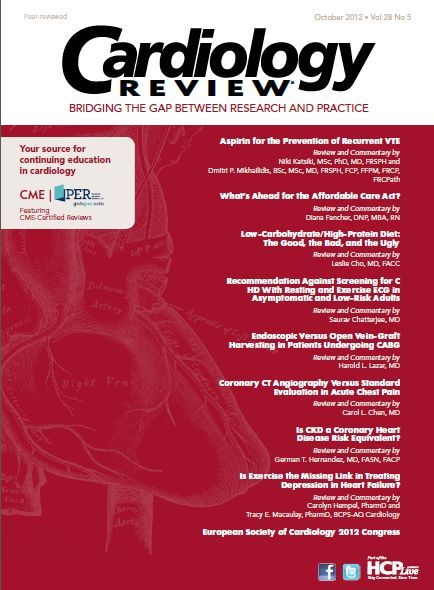Getting Ready for Winter's Arrival

Debabrata Mukherjee, MD, MS, FACC
Editor-in-Chief
As winter comes knocking on our doors, I hope you will find time to sit near a crackling fireplace with a hot cup of cocoa and enjoy your copy of Cardiology Review.
This issue of the journal discusses many important articles and viewpoints that I am sure you will find enjoyable and useful.
Dr Carol Chen discusses the role of coronary CT angiography (CCTA) versus standard evaluation in patients with acute chest pain. She suggests that in patients who are to undergo myocardial perfusion imaging testing, CCTA remains an option as an initial diagnostic procedure, with a favorable cost and radiation exposure profile. She goes on to say that by choosing the right patient and algorithm, CCTA could reduce overall hospital costs, and she cautions against the potential hazards of its inappropriate use in low-risk patients.
Dr Leslie Cho discusses pros and cons of a low-carbohydrate/ high-protein diet and reports that while the low-carb/ high-vegetable-protein diet may have cardiovascular benefits, most patients who go on low-carb/high-protein diets elect to have diets high in animal protein because they are often the cheapest and most easily accessible. Even in a low-risk population of young, thin women, a diet low in carbohydrates and high in animal protein can increase the risk of cardiovascular disease long term. We are reminded that in the fight against obesity, where much confusion reigns among both patients and physicians about what diet to recommend and follow, a healthy diet is a balanced diet and one of moderation. Also addressing lifestyle modifications, Dr Carolyn Hempel discusses structured and supervised exercise as a treatment for depression and as a means of improving clinical outcomes in heart failure (HF) patients, and suggests that current evidence justifies increased counseling and, potentially, administration of structured exercise programs for patients suffering from symptomatic HF— particularly patients with severe clinical depression.
Dr German Hernandez discusses chronic kidney disease (CKD) as a coronary heart disease risk equivalent. Based on data that patients with CKD are at high risk, he recommends consideration of lipid-lowering therapy in patients with more severe CKD (eGFR 15 mL/min/1.73 m2 to 44 mL/min/1.73 m2 or with severe proteinuria). Dr Niki Katsiki reviews the role of aspirin for the prevention of recurrent venous thromboembolism (VTE), and states that while aspirin seems promising in preventing
recurrent VTE, more trials are needed to address this issue. The ongoing ASPIRE trial will likely provide additional insight.
Dr Harold Lazar discusses endoscopic versus open vein-graft harvesting in patients undergoing coronary artery bypass grafting (CABG) and reports that despite some of the difficulties with endoscopic vein harvesting, it represents a major breakthrough in minimizing the morbidity associated with leg vein harvesting in CABG surgery. The decreased leg morbidity associated with this technique does not come at the expense of increased long-term mortality or myocardial infarctions, or result in an increased incidence of the need for repeat revascularization procedures.
Dr Saurav Chatterjee discuses new evidence and a recommendation against screening for CHD with resting or exercise ECG in asymptomatic, low-risk adults. He reports that there is no convincing evidence to recommend for or against such screening in high-risk individuals. Thus, future studies are urgently needed to identify patients in whom such screening may lead to significant reduction in CHD events and to identify tools for appropriate risk stratification.
Dr Diana Fancher touches on an important societal issue that is uppermost in many physicians’ minds: the implications of the Affordable Care Act (ACA). She points out that the ACA is the first US law to attempt comprehensive and systemic health care delivery reform, and hopes that both sides of the political aisle will be working together to assess, modify, and rework elements of the law. She quotes John E. McDonough, DrPH, of the Department of Health Policy and Management at the Harvard School of Public Health, who said, “Perhaps we will still get there, but there are many obstacles ahead.”
For our Diabetes and Health section, Dr Aparna Bhagavat reflects on insulin resistance and cardiovascular disease, and suggests that the main goal should be to reduce insulin resistance by recommending weight loss and increased physical activity—which should be stressed to patients in cardiology, primary care, and endocrinology clinics. A significant proportion of time should be spent on educating patients to eat right and exercise rather than only increasing their oral medications
or insulin to achieve a better A1C using either nutritionists or diabetes nurse specialists.
In addition, Ms Jackie Syrop, our excellent managing editor, summarizes key presentations at ESC 2012 to help keep us all up-to-date on major recent cardiovascular trials.
I encourage you to share your insights, thoughts, and personal experiences on the topics touched upon in this issue. On a broader level, I would love to hear feedback on how we can make this journal even better. My goal continues to be to make you look forward to every issue of Cardiology Review.
